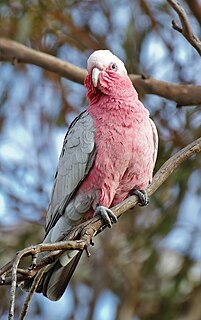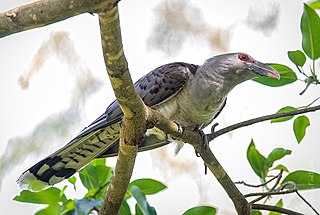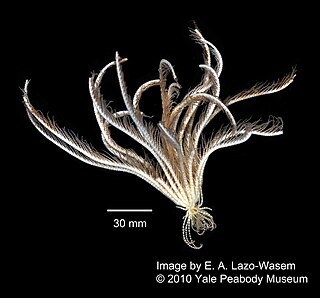
Tasmania, abbreviated as TAS, is an island state of Australia. It is located 240 km (150 mi) to the south of the Australian mainland, separated from it by Bass Strait. The state encompasses the main island of Tasmania, the 26th-largest island in the world, and the surrounding 1000 islands. It is Australia's least populated state, with 541,965 residents as of March 2021. The state capital and largest city is Hobart, with around 40 percent of the population living in the Greater Hobart area.

An echinoderm is any member of the phylum Echinodermata of marine animals. The adults are recognizable by their radial symmetry, and include starfish, sea urchins, sand dollars, and sea cucumbers, as well as the sea lilies or "stone lilies". Adult echinoderms are found on the sea bed at every ocean depth, from the intertidal zone to the abyssal zone. The phylum contains about 7000 living species, making it the second-largest grouping of deuterostomes, after the chordates. Echinoderms are the largest phylum that has no freshwater or terrestrial members.

Crinoids are marine animals that make up the class Crinoidea, one of the classes of the phylum Echinodermata, which also includes the starfish, brittle stars, sea urchins and sea cucumbers. Those crinoids which, in their adult form, are attached to the sea bottom by a stalk are commonly called sea lilies, while the unstalked forms are called feather stars or comatulids, being members of the largest crinoid order, Comatulida.

The morepork, also called the ruru or Tasmanian spotted owl, is a small brown owl found throughout New Zealand and Tasmania. Described by Johann Friedrich Gmelin in 1788, it was for many years considered to be the same species as the Australian boobook of mainland Australia until 1999. Its name is derived from its two-tone call. Four subspecies of the morepork are recognized, one of which is extinct and another that exists only as a hybrid population. The bird has almost 20 alternative common names, including mopoke and boobook—many of these names are onomatopoeic, as they emulate the bird's distinctive two-pitched call.

The black currawong, also known locally as the black jay, is a large passerine bird endemic to Tasmania and the nearby islands within the Bass Strait. One of three currawong species in the genus Strepera, it is closely related to the butcherbirds and Australian magpie within the family Artamidae. It is a large crow-like bird, around 50 cm (20 in) long on average, with yellow irises, a heavy bill, and black plumage with white wing patches. The male and female are similar in appearance. Three subspecies are recognised, one of which, Strepera fuliginosa colei of King Island, is vulnerable to extinction.

The western grey kangaroo, also referred to as a western grey giant kangaroo, black-faced kangaroo, mallee kangaroo, and sooty kangaroo, is a large and very common kangaroo found across almost the entire southern part of Australia, from just south of Shark Bay through coastal Western Australia and South Australia, into western Victoria, and in the entire Murray–Darling basin in New South Wales and Queensland.

The little pied cormorant, little shag or kawaupaka is a common Australasian waterbird, found around the coasts, islands, estuaries, and inland waters of Australia, New Guinea, New Zealand, Thailand, Myanmar, Singapore, Brunei, Timor Leste, and Indonesia, and around the islands of the south-western Pacific and the subantarctic. It is a small short-billed cormorant usually black above and white below with a yellow bill and small crest, although a mostly black white-throated form predominates in New Zealand. Three subspecies are recognised. Until recently most authorities referred to this species as Phalacrocorax melanoleucos.

The Pacific gull is a very large gull, native to the coasts of Australia. It is moderately common between Carnarvon in the west, and Sydney in the east, although it has become scarce in some parts of the south-east, as a result of competition from the kelp gull, which has "self-introduced" since the 1940s.

The galah, also known as the pink and grey cockatoo or rose-breasted cockatoo, is the only species within genus Eolophus of the cockatoo family. Found throughout Australia, it is among the most common of the cockatoos. With its distinctive pink and grey plumage and its bold and loud behaviour, it is a familiar sight in the wild and increasingly in urban areas. It has benefited from the change in the landscape since European colonisation, and appears to be replacing the Major Mitchell's cockatoo in parts of its range.

The Typhlopidae are a family of blind snakes. They are found mostly in the tropical regions of Africa, Asia, the Americas, and all mainland Australia and various islands. The rostral scale overhangs the mouth to form a shovel-like burrowing structure. They live underground in burrows, and since they have no use for vision, their eyes are mostly vestigial. They have light-detecting black eye spots, and teeth occur in the upper jaw. Typhlopids do not have dislocatable lower jaw articulations restricting them to prey smaller than their oral aperture. The tail ends with a horn-like scale. Most of these species are oviparous. Currently, 18 genera are recognized containing over 200 species.

The eastern barred bandicoot is a nocturnal, rabbit-sized marsupial endemic to southeastern Australia, being native to the island of Tasmania and mainland Victoria. It is one of three surviving bandicoot species in the genus Perameles. It is distinguishable from its partially-sympatric congener – the long-nosed bandicoot – via three or four dark horizontal bars found on its rump. It is the only species of bandicoot found on Tasmania, where it is relatively abundant. The mainland population in Victoria is struggling and is subject to ongoing conservation endeavors.

The rainbow lorikeet is a species of parrot found in Australia. It is common along the eastern seaboard, from northern Queensland to South Australia. Its habitat is rainforest, coastal bush and woodland areas. Six taxa traditionally listed as subspecies of the rainbow lorikeet are now treated as separate species.

The swamp antechinus, also known as the little Tasmanian marsupial mouse, is a species of shrew-like marsupial of the family Dasyuridae and as such is related to dunnarts, quolls and the Tasmanian devil.

The channel-billed cuckoo is a species of cuckoo in the family Cuculidae. It is monotypic within the genus Scythrops. The species is the largest brood parasite in the world, and the largest cuckoo.

The crinoid shrimp, or feather star shrimpHippolyte catagrapha, is a species of shrimp in the family Hippolytidae

Florometra serratissima is a species of crinoid or feather star in the family Antedonidae. It is found off the Pacific coast of North America, usually in deep water.

Promachocrinus is a genus of free-swimming, stemless crinoids. It is a monotypic genus, and the only species in the genus is Promachocrinus kerguelensis. This is a coldwater crinoid which is found in the seas around Antarctica and surrounding island groups, including under the sea ice.

Aporometra wilsoni is a marine invertebrate, a species of crinoid or feather star in the family Aporometridae. It is found in shallow water around the coasts of southern Australia.

Notocrinus virilis is a marine invertebrate, a species of crinoid or feather star in the family Notocrinidae. It is found in deep water in the Southern Ocean around the coasts of Antarctica and adjacent islands. A sea snail sometimes parasitizes it.



















